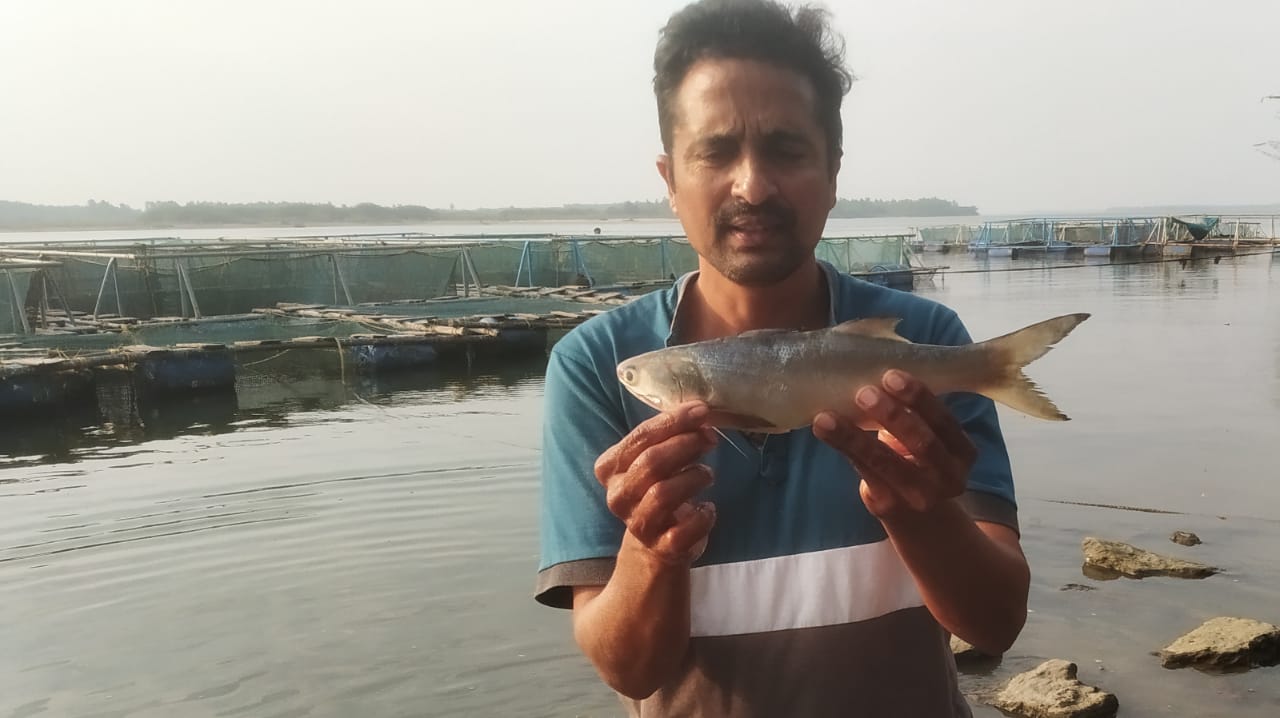An uncertain marine export market goads Andhra farmer to experiment with much sought-after salmon; profits look good.

Talasila Raghu Sekhar, who grows Indian salmon in Krishna district of Andhra Pradesh. (Supplied)
The Indian salmon, a nutritious and sought-after marine fish available only in small quantities, may finally be marketed in bulk this year if an Andhra fish farmer’s experiment with it is successful.
In the process, the cultured salmon could also become an alternative to vanamei (whiteleg shrimp) and tiger shrimp, on which Andhra’s aquaculture industry is heavily dependent.
Andhra Pradesh accounts for a lion’s share of India’s overall shrimp exports; for instance, it was ₹27,476 crore in 2021-22, or 34.76 percent of India’s total shrimp export of ₹57,586 crore.
However, the sector is grappling with a number of issues such as cartels and high power costs for shrimp farmers, as well as intense competition from countries such as Ecuador and Vietnam in the international market.
A successful outcome of the experiment with the Indian salmon could bring some good news for the distressed sector, hopes the man behind it.
“It’s scarce, it’s tasty, and it’s nutritious,” Talasila Raghu Sekhar told South First. “These are its USP.”
Sekhar’s prediction: “I am sure the salmon will fetch the farmers a good price.”
Sekhar, primarily a sea bass farmer, started farming salmon in two cages four months ago in September last year in the salty backwaters of Krishna river at Nagayalanka in Krishna district.
He had spent almost five years researching salmon, accessing literature and reading it, and is currently in the process of farming at least 2,000 fish in cages — netted enclosed structures in a water body that allows free exchange of water. He had also interacted with several fish farmers to understand salmon fish.
Sekhar is expecting a bounty of at least a 1,000 kg of cultured salmon four months from now, around May-June. That should spell a pretty packet for him; on 9 January, salmon was going for ₹300 a kg in the state.
“Each fish is now estimated to be half a kilo and healthy,” he said. “I expect them to gain in size and weight in the next four months when I hit the market after the first harvest.” Harvesting is the process of gathering and removing fish from the place in which it has grown.
Though Sekhar’s business interest is in sea bass, he has always felt fish farmers in Andhra Pradesh were overly dependent on shrimps, which made them vulnerable to uncertain market conditions.
“There are lakhs of farmers depending on prawn farming in Andhra Pradesh,” he said.
“Any slight disturbance in the international market will have a chain reaction and its effect will be felt here, and these farmers will be crippled.”
It was the fear of the uncertainties around the trade that drove Sekhar to look at farming salmon; this, and the realisation that a fish that is not readily available despite a huge demand for it can be cultured for profits.
Sekhar wants the salmon aquaculture to catch on. “The seed can be found at the river mouths,” he said, referring to baby fish used for seeding new ponds or cages.
Babies are born when the salmon swim upstream inland to spawn. As the salmon are available in smaller quantities in the sea, Sekhar had trained a few fishermen in the vicinity on how to identify salmon fish seed at the sea mouth.
With the help of local fishermen, he had collected salmon fish seeds and is now growing the fish in cages.
Aquaculture – or fish farming in cages – is a low-impact farming practice with high economic returns yielding 10-12 times the produce of pond fish culture.
It also has the least carbon emission footprint. Fish farming on an existing body of water eliminates one of the main obstacles to fish farming on land, namely the requirement of a steady supply of clean, oxygenated water.
Fish get oxygen and other necessary nutrients when cage farms are positioned to take advantage of natural currents.
It was introduced in the estuarine and coastal waters in different parts of the country after successful demonstrations in the sea.
The comparatively low initial investment and recurring expenditure, ease of operations, short duration of culture, and high returns per unit make cage aquaculture a widely accepted farming practice.
Currently, only four varieties of marine fish, including sea bass and pompano, are aquacultured in Andhra Pradesh, that too in small quantities.
“In India, we have the knowhow to farm only four varieties of saltwater fish in the cage, which are sold in the markets at very low prices,” Sekhar said. “But if farmers manage to breed salmon in bulk, I am sure they will earn well.”
Agrees Dr S Kandan, director, Rajiv Gandhi Centre for Aquaculture: “It will be viable to take up salmon fish farming.”
Like Sekhar, Dr Kandan is betting on the “high demand” for the fish.
“Salmon can be an alternative to other aquaculture varieties that are being reared by our farmers,” he told South First.
Indian salmon, also known as rawas or gurjali and mostly found off the country’s western coast, is an oily seawater fish with a firm flesh texture.
Popular for its mild flavour, salmon is also considered healthy because of its high protein value, Omega-3 fatty acid, and vitamin D content.
According to the American Heart Association, eating healthy unsaturated fats, like those found in salmon, is a good way to improve cholesterol levels. Salmon is considered a great alternative to red meat because it’s a nutrient-dense food that can help raise good cholesterol levels.
The salmon flesh is typically orange to red, but white-fleshed wild salmon with white-black skin do exist.

Apr 19, 2024

Apr 19, 2024

Apr 18, 2024

Apr 18, 2024

Apr 18, 2024